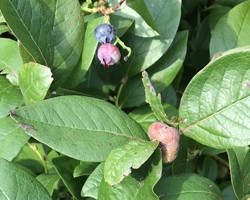Managing Blueberry Stem Gall Wasp in New York
Esther Kibbe, WNY Berry Specialist
Harvest New York

THE WASP
In the past few months, several growers across WNY have observed stem galls in their blueberry fields. While somewhat uncommon, the blueberry stem gall wasp (Hemadas nubilipennis) is an insect native to Eastern North America. It is found in both low and high bush blueberry plants in the wild and in cultivated fields. In some regions and varieties the wasp can multiply to high levels, causing economic injury in commercial fields. The Jersey and Liberty varieties are very susceptible and have been hit hard in Michigan, while other varieties appear resistant or immune. (Fruit Grower News 6/18/19)
This wasp is very small and sometimes hard to spot, but the galls are more obvious. The galls are a protective structure for the developing eggs and larvae, where they feed and overwinter. The adults emerge from the galls in the spring, right around bloom time. Female wasps lay eggs in the blueberry stems, then stab the growing end of the stem several times, halting growth. The eggs hatch into larvae, which release hormones that trigger excessive tissue growth (the galls) that serves as the food for the larvae. Each gall will house multiple larvae. A grower in NY observed 2 periods of gall development, in the spring and later in the summer, but it is unknown whether this was a true 2nd generation, or simply some late-emerging adults. The wasps cannot fly far, so galls tend to appear in a limited area. Further spread is likely due to adults being blown to new locations.
Spray programs targeting other insects (such as cranberry and cherry fruitworms) may be suppressing this wasp in conventionally managed fields. Organic or low-spray operations have shown more frequent outbreaks of stem galls.
MANAGEMENT
Blueberry stem gall wasps are only a concern in some susceptible varieties. There are no insecticides currently labeled (in New York) against this pest. However, there are some cultural control approaches, starting with planting resistant or tolerant cultivars, such as Bluecrop, Blueray, Spartan, Draper, Nelson and Elliott. Liberty and Jersey should be avoided. The susceptibility of other cultivars is not well documented.
If a grower has susceptible varieties with galls, the next cultural control is to prune out as many galls as possible during the winter. The galls should be burned or bagged and removed from the field. If the infestation is so severe that the entire plant is involved, consider removing the plants. There is some anecdotal evidence that eggs can be laid (and galls formed) on shallow roots as well as stems, so that adults could be emerging even when no galls are visible in the bushes, continuing the infestation. It is important to look for and remove galls while doing normal dormant pruning, to avoid a larger population developing to the point where economic harm occurs.
With the adult emergence coinciding with bloom, any potential chemical control would require extreme care to avoid harming pollinators. In Michigan, where this pest is a major concern, there is a special label for a prebloom spray, and some indication that petal fall sprays (after bees are removed) could reduce survival of larvae in galls. Similar special exemptions could be pursued in New York if growers are struggling with this pest. Contact Esther Kibbe or Greg Loeb if you are dealing with blueberry stem gall wasp and would like Cornell to pursue a label exemption.
Upcoming Events
Whole Farm Climate Adaptation and Mitigation Planning (CAMP) Series
January 13 - February 12, 2026
Jan 13, Jan 29: 10:00 AM - 4:00 PM; Feb 12: 1:00 - 4:00 PM
Kingston, NY
Join CCE Ulster and CCE Harvest New York for a three-part workshop series focused on building climate resilience on your farm. We will cover climate change adaptation and mitigation strategies, learn how to access relevant historical climate data, and begin a climate adaptation plan for your farm!January 13 (Tues): 10:00 AM - 4:00 PM
January 29 (Thurs): 10:00 AM - 4:00 PM
February 12 (Thurs): 1:00 PM - 4:00 PM
